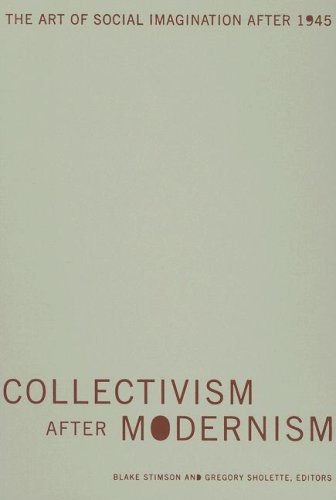Artículos relacionados a Collectivism after Modernism: The Art of Social Imagination...

Críticas:
" Contrary to some strains of popular belief, collectivism is artmaking not only with" many but for" many. For the historical avant-garde- like the Dadaists or the Constructivists- it embodied the revolutionary power of communal force, one that would, in the future, alleviate the alienation of capitalist individualism. For artists during the Cold War, it meant sharing an experience beyond that of mass consumption, at a time when the communal utopias of the recent past were, at best, dismissed as nai ve phantasmagorias or, at worst, seen as having materialized in the form of totalitarian regimes. And a few years ago, fueled by curatorial interest, a trend emerged of group art practice as a kind of clubby tribalism. To understand the various forms of postwar collectivism as historically determined phenomena and to articulate the possibilities for contemporary collectivist art production is the aim of "Collectivism after Modernism. "The essays assembled in this anthology argue that to make truly collective art means to reconsider the relation between art and public; examples from the Situationist International and Group Material to Paper Tiger Television and the Congolese collective Le Groupe Amos make the point. To construct an art of shared experience means to go beyond projecting what Blake Stimson and Gregory Sholette call the " imagined community" a collective has to be more than an ideal, and more than communal craft; it has to be a truly social enterprise. Not only does it use unconventional forms and media to communicate the issues and experiences usually excluded from artistic representation, but it gives voice to a multiplicity ofperspectives. At its best it relies on the participation of the audience to actively contribute to the work, carrying forth the dialogue it inspires." - "BOMB"
Reseña del editor:
"Don't start an art collective until you read this book." --Guerrilla Girls "Ever since Web 2.0 with its wikis, blogs and social networks the art of collaboration is back on the agenda. Collectivism after Modernism convincingly proves that art collectives did not stop after the proclaimed death of the historical avant-gardes. Like never before technology reinvents the social and artists claim the steering wheel!" --Geert Lovink, Institute of Network Cultures, Amsterdam "This examination of the succession of post-war avant-gardes and collectives is new, important, and engaged." -- Stephen F. Eisenman, author of The Abu Ghraib Effect "Collectivism after Modernism crucially helps us understand what artists and others can do in mushy, stinky times like ours. What can the seemingly powerless do in the face of mighty forces that seem to have their act really together? Here, Stimson and Sholette put forth many good answers." --Yes Men Spanning the globe from Europe, Japan, and the United States to Africa, Cuba, and Mexico, Collectivism after Modernism explores the ways in which collectives function within cultural norms, social conventions, and corporate or state-sanctioned art. Together, these essays demonstrate that collectivism survives as an influential artistic practice despite the art world's star system of individuality. Collectivism after Modernism provides the historical understanding necessary for thinking through postmodern collective practice, now and into the future. Contributors: Irina Aristarkhova, Jesse Drew, Okwui Enwezor, Rub n Gallo, Chris Gilbert, Brian Holmes, Alan Moore, Jelena Stojanovi c, Reiko Tomii, Rachel Weiss. Blake Stimson is associate professor of art history at the University of California Davis, the author of The Pivot of the World: Photography and Its Nation, and coeditor of Visual Worlds and Conceptual Art: A Critical Anthology. Gregory Sholette is an artist, writer, and cofounder of collectives Political Art Documentation/Distribution and REPOhistory. He is coeditor of The Interventionists: Users' Manual for the Creative Disruption of Everyday Life. "To understand the various forms of postwar collectivism as historically determined phenomena and to articulate the possibilities for contemporary collectivist art production is the aim of Collectivism after Modernism. The essays assembled in this anthology argue that to make truly collective art means to reconsider the relation between art and public; examples from the Situationist International and Group Material to Paper Tiger Television and the Congolese collective Le Groupe Amos make the point. To construct an art of shared experience means to go beyond projecting what Blake Stimson and Gregory Sholette call the "imagined community" a collective has to be more than an ideal, and more than communal craft; it has to be a truly social enterprise. Not only does it use unconventional forms and media to communicate the issues and experiences usually excluded from artistic representation, but it gives voice to a multiplicity of perspectives. At its best it relies on the participation of the audience to actively contribute to the work, carrying forth the dialogue it inspires." --BOMB
"Sobre este título" puede pertenecer a otra edición de este libro.
- EditorialUniversity of Minnesota Press
- Año de publicación2007
- ISBN 10 0816644616
- ISBN 13 9780816644612
- EncuadernaciónTapa dura
- Número de páginas304
- EditorStimson Blake, Sholette Gregory
- Valoración
(Ningún ejemplar disponible)
Buscar: Crear una peticiónSi conoce el autor y el título del libro pero no lo encuentra en IberLibro, nosotros podemos buscarlo por usted e informarle por e-mail en cuanto el libro esté disponible en nuestras páginas web.
Crear una petición
